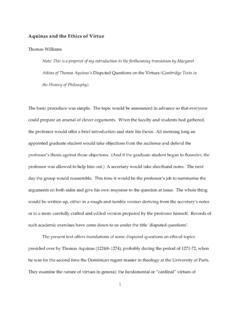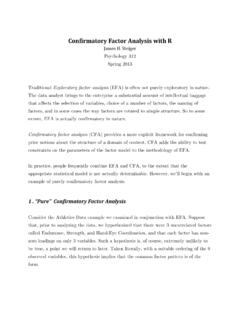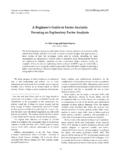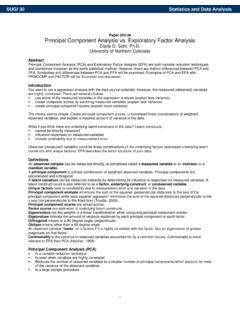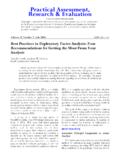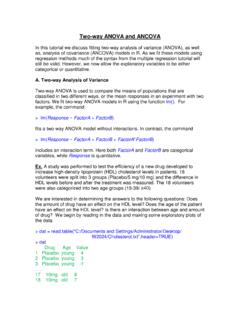Transcription of Five-Factor Model of Personality and Job …
1 Five-Factor Model of Personality and Job satisfaction : A Meta-AnalysisTimothy A. JudgeUniversity of FloridaDaniel Heller and Michael K. MountUniversity of IowaThis study reports results of a meta- analysis linking traits from the 5-factor Model of Personality tooverall job satisfaction . Using the Model as an organizing framework, 334 correlations from 163independent samples were classified according to the Model . The estimated true score correlations withjob satisfaction were.
2 29 for Neuroticism, .25 for Extraversion, .02 for Openness to Experience, .17 forAgreeableness, and .26 for Conscientiousness. Results further indicated that only the relations ofNeuroticism and Extraversion with job satisfaction generalized across studies. As a set, the Big five traitshad a multiple correlation of .41 with job satisfaction , indicating support for the validity of thedispositional source of job satisfaction when traits are organized according to the 5-factor on the dispositional source of job satisfaction has hada spotty history in job satisfaction research.
3 The personologicalbasis of job satisfaction was considered in the earliest treatments ofjob satisfaction . Hoppock (1935), for example, noted a strongcorrelation between workers emotional adjustment and their lev-els of job satisfaction . Similarly, Fisher and Hanna (1931) con-cluded that a large part of dissatisfaction resulted from emotionalmaladjustment. With some noteworthy exceptions (P. C. Smith,1955; Weitz, 1952), these early considerations of the dispositionalsource of job satisfaction lay dormant until the 1980s, when aseries of provocative studies (Arvey, Bouchard, Segal, & Abra-ham, 1989; Staw, Bell, & Clausen, 1986; Staw & Ross, 1985) ledto renewed interest in the relationship.
4 In the past 15 years, anexpanding literature has accumulated, giving general support to theargument that job satisfaction is, in part, dispositionally based(House, Shane, & Herold, 1996). Despite this widespread accep-tance, a broad array of traits has been investigated, and there hasbeen little integration in the literature. As Spector (1997) noted, Although many traits have been shown to correlate significantlywith job satisfaction , most research with Personality has done littlemore than demonstrate relations without offering much theoreticalexplanation (p.)
5 51).One factor that has impeded theoretical explanations of thedispositional source of job satisfaction is the lack of a frameworkdescribing the structure and nature of Personality . Thousands oftraits have been invented in the history of Personality research, andscores of traits have been studied in relation to job satisfaction . AsArvey, Carter, and Buerkley (1991) commented, There is confu-sion regarding which person variables should be examined. Aformidable array of person variables have been discussed as pos-sible determinants of job satisfaction in the research literature ( ).
6 When specific traits have been selected for inclusion instudies of employee attitudes, it generally has been in a piecemealfashion. Advances in Personality research, however, provide thepotential for assimilation and typology that has been in this research literature is thepositive affectivity (PA)-negative affectivity (NA) taxonomy ofaffective temperament (D. Watson, 2000). Research by Watson,Tellegen, and colleagues suggests that affective disposition iscomposed of two facets: PA and NA.
7 High-PA individuals arepredisposed to experience positive emotionality ( , joy, excite-ment, enthusiasm), whereas high-NA individuals are predisposedto experience negative emotions ( , guilt, anger, fear; , Clark, & Tellegen, 1988). In a meta- analysis of therelation of affectivity to job satisfaction , Connolly and Viswesva-ran (2000) reported true score correlations of PA and NA with jobsatisfaction of .49 (k 15) and .33 (k 27), the PA-NA typology has proven to be quite useful ininvestigating the dispositional source of job satisfaction , severallimitations exist.
8 First, given the higher correlations of PA with jobsatisfaction, it is surprising that more research has been focused onNA, in many cases to the exclusion of PA ( , Levin & Stokes,1989; Necowitz & Roznowski, 1994). Second, the issue of theindependence of PA and NA continues to be debated in theliterature (Russell & Carroll, 1999a, 1999b; D. Watson & Telle-gen, 1999). Some argue that it is inappropriate to treat PA and NAas separate concepts: that the traits represent opposite ends ofsingle bipolar construct or that a circumplex is required to take therelationships among the concepts into account (Carroll, Yik, Rus-sell, & Barrett, 1999).
9 Others suggest that PA-NA may assess, atleast in part, current levels of happiness, affect experienced, or lifesatisfaction (Judge & Locke, 1993). Finally, the PA-NA taxonomyincludes only two traits. Other traits may exist that are theoreticallyand empirically relevant to job the last 20 years, consensus has emerged that a Five-Factor Model of Personality , often termed the Big five (Goldberg,1990), can be used to describe the most salient aspects of person-ality. The Five-Factor structure has generalized across measures,cultures, and sources of ratings (McCrae & John, 1992).
10 AlthoughTimothy A. Judge, Department of Management, University of Florida;Daniel Heller, Department of Psychology, University of Iowa; Michael , Department of Management and Organizations, University concerning this article should be addressed to TimothyA. Judge, Department of Management, Warrington College of Business,University of Florida, Gainesville, Florida 32611. E-mail: of Applied PsychologyCopyright 2002 by the American Psychological Association, , Vol. 87, No. 3, 530 5410021-9010/02/$ DOI: Five-Factor Model has been researched in many areas ofindustrial-organizational psychology, most notably with respect tojob performance (Barrick & Mount, 1991), the relationship of thefive-factor Model to job satisfaction is much less studied.
